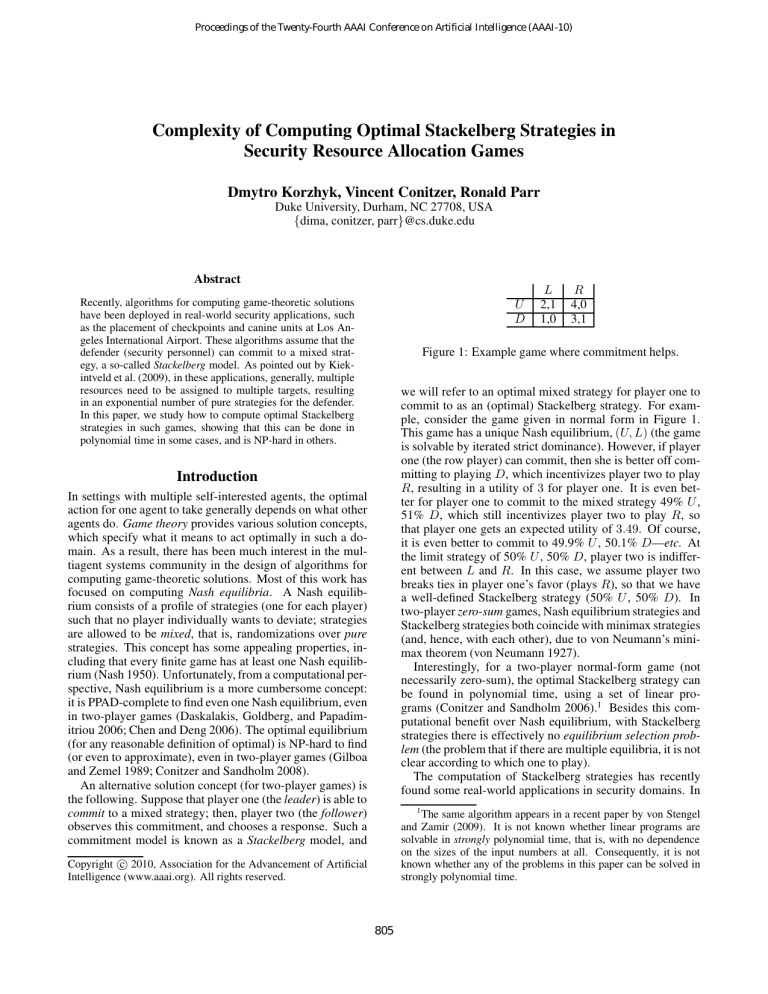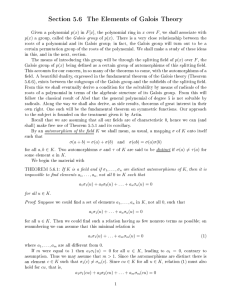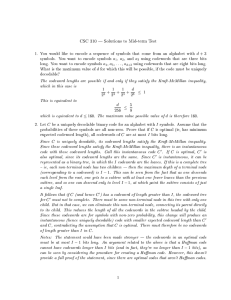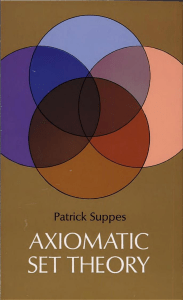
Proceedings of the Twenty-Fourth AAAI Conference on Artificial Intelligence (AAAI-10)
Complexity of Computing Optimal Stackelberg Strategies in
Security Resource Allocation Games
Dmytro Korzhyk, Vincent Conitzer, Ronald Parr
Duke University, Durham, NC 27708, USA
{dima, conitzer, parr}@cs.duke.edu
Abstract
Recently, algorithms for computing game-theoretic solutions
have been deployed in real-world security applications, such
as the placement of checkpoints and canine units at Los Angeles International Airport. These algorithms assume that the
defender (security personnel) can commit to a mixed strategy, a so-called Stackelberg model. As pointed out by Kiekintveld et al. (2009), in these applications, generally, multiple
resources need to be assigned to multiple targets, resulting
in an exponential number of pure strategies for the defender.
In this paper, we study how to compute optimal Stackelberg
strategies in such games, showing that this can be done in
polynomial time in some cases, and is NP-hard in others.
U
D
L
2,1
1,0
R
4,0
3,1
Figure 1: Example game where commitment helps.
we will refer to an optimal mixed strategy for player one to
commit to as an (optimal) Stackelberg strategy. For example, consider the game given in normal form in Figure 1.
This game has a unique Nash equilibrium, (U, L) (the game
is solvable by iterated strict dominance). However, if player
one (the row player) can commit, then she is better off committing to playing D, which incentivizes player two to play
R, resulting in a utility of 3 for player one. It is even better for player one to commit to the mixed strategy 49% U ,
51% D, which still incentivizes player two to play R, so
that player one gets an expected utility of 3.49. Of course,
it is even better to commit to 49.9% U , 50.1% D—etc. At
the limit strategy of 50% U , 50% D, player two is indifferent between L and R. In this case, we assume player two
breaks ties in player one’s favor (plays R), so that we have
a well-defined Stackelberg strategy (50% U , 50% D). In
two-player zero-sum games, Nash equilibrium strategies and
Stackelberg strategies both coincide with minimax strategies
(and, hence, with each other), due to von Neumann’s minimax theorem (von Neumann 1927).
Interestingly, for a two-player normal-form game (not
necessarily zero-sum), the optimal Stackelberg strategy can
be found in polynomial time, using a set of linear programs (Conitzer and Sandholm 2006).1 Besides this computational benefit over Nash equilibrium, with Stackelberg
strategies there is effectively no equilibrium selection problem (the problem that if there are multiple equilibria, it is not
clear according to which one to play).
The computation of Stackelberg strategies has recently
found some real-world applications in security domains. In
Introduction
In settings with multiple self-interested agents, the optimal
action for one agent to take generally depends on what other
agents do. Game theory provides various solution concepts,
which specify what it means to act optimally in such a domain. As a result, there has been much interest in the multiagent systems community in the design of algorithms for
computing game-theoretic solutions. Most of this work has
focused on computing Nash equilibria. A Nash equilibrium consists of a profile of strategies (one for each player)
such that no player individually wants to deviate; strategies
are allowed to be mixed, that is, randomizations over pure
strategies. This concept has some appealing properties, including that every finite game has at least one Nash equilibrium (Nash 1950). Unfortunately, from a computational perspective, Nash equilibrium is a more cumbersome concept:
it is PPAD-complete to find even one Nash equilibrium, even
in two-player games (Daskalakis, Goldberg, and Papadimitriou 2006; Chen and Deng 2006). The optimal equilibrium
(for any reasonable definition of optimal) is NP-hard to find
(or even to approximate), even in two-player games (Gilboa
and Zemel 1989; Conitzer and Sandholm 2008).
An alternative solution concept (for two-player games) is
the following. Suppose that player one (the leader) is able to
commit to a mixed strategy; then, player two (the follower)
observes this commitment, and chooses a response. Such a
commitment model is known as a Stackelberg model, and
1
The same algorithm appears in a recent paper by von Stengel
and Zamir (2009). It is not known whether linear programs are
solvable in strongly polynomial time, that is, with no dependence
on the sizes of the input numbers at all. Consequently, it is not
known whether any of the problems in this paper can be solved in
strongly polynomial time.
Copyright c 2010, Association for the Advancement of Artificial
Intelligence (www.aaai.org). All rights reserved.
805
these games, the defender (security personnel) places security resources (e.g., guards) at various potential targets
(possibly in a randomized manner), and then the attacker
chooses a target to attack. The defender takes the role of the
leader. Los Angeles International Airport now uses an algorithm for computing Stackelberg strategies to place checkpoints and canine units randomly (Paruchuri et al. 2008;
Pita et al. 2009).
However, as was pointed out by Kiekintveld et al. (2009),
the applicability of these techniques to security domains is
limited by the fact that the defender generally has exponentially many pure strategies, so that it is not feasible to write
out the entire normal form of the game. Specifically, if there
are m indistinguishable defensive resources, and n targets
to
n
which they can be assigned (n > m), then there are m
pure
strategies (allocations) for the defender. Kiekintveld et al.
point out that while the LAX application was small enough
to enumerate all strategies, this is not the case for new applications, including the problem of assigning Federal Air
Marshals to flights (Tsai et al. 2009). They provide a nice
framework for representing this type of problem; we follow
this framework in this paper (and review it in the following section). However, their paper leaves open the computational complexity of finding the optimal Stackelberg strategy
in their framework. In this paper, we resolve the complexity
of all the major variants in their framework, in some cases
giving polynomial-time algorithms, and in other cases giving NP-hardness results.
be simultaneously covered by some resource. We assume
that any subset of a schedule is also a schedule, that is,
if s′ ⊆ s and s ∈ S, then s′ ∈ S. When resources are
assigned to individual targets, we have (by a slight abuse
of notation) S = T ∪ {∅}, where ∅ corresponds to not
covering any target.
• Resources. Described by a set Ω (|Ω| = m). When
there are different types of resources, there is a function
A : Ω 2S , where A(ω) is the set of schedules to which
resource ω can be assigned. We assume that if s′ ⊆ s
and s ∈ A(ω), then s′ ∈ A(ω)—that is, if a resource can
cover a set of targets simultaneously, then it can also cover
any subset of that set of targets simultaneously. If resources are homogeneous, then we assume every resource
can cover all schedules, that is, A(ω) = S for all ω ∈ Ω.
• Utility functions. If target t is attacked, the defender’s
utility is Udc (t) if t is covered, or Udu (t) if t is not covered.
The attacker’s utility is Uac (t) if t is covered, or Uau (t) if t
is not covered. We assume Udc (t) ≥ Udu (t) and Uac (t) ≤
Uau (t). We note that it makes no difference to the players’
utilities whether a target is covered by one resource or by
more than one resource.
LP notation. We will use linear programs in all of our
positive results (polynomial-time algorithms). We now describe some of the variables used in these linear programs.
• ct is the probability of target t being covered.
• cs is the probability of schedule s being covered.
Problem Description and Notation
Following Kiekintveld et al. (2009), we consider the following two-player general-sum game. Player one (the “leader”
or “defender”) commits to a mixed strategy to allocate a set
of resources to defend a set of targets.2 Player two (the
“follower” or “attacker”) observes the commitment and then
picks one of the targets to attack. The utilities of the players
depend on which target was attacked and whether that target
was defended.
We will consider several variants of this game. Resources
of the leader can be either homogeneous, or there can be
several types of resources, each with different limitations on
what they can defend. It can either be the case that a resource can be assigned to at most one target, or it can be the
case that a resource can be assigned to a subset of the targets (such a subset is called a schedule). As we will see, the
complexity depends on the size of these schedules.
We will use the following notation to describe different
variants of the problem.
• Targets. Described by a set T (|T | = n). A target t is
covered if there is a resource assigned to t (in the case of
no schedules), or if a resource is assigned to a schedule
that includes t.
• Schedules. Described by a collection of subsets of targets
S ⊆ 2T . Here, s ∈ S is a subset of targets that can
• cω,s is the probability of resource ω being assigned to
schedule s.
Let c denote the vector of probabilities (c1 , . . . , cn ). Then,
the utilities of the leader and the follower can be computed
as follows, given c and the target t being attacked:
Ud (t, c) = ct Udc (t) + (1 − ct )Udu (t)
Ua (t, c) = ct Uac (t) + (1 − ct )Uau (t)
These equalities are implicit in all of our linear programs
and, for brevity, are not repeated.
Standard multiple LPs approach. As a benchmark and
to illustrate some of the ideas, we first describe the standard algorithm for computing a Stackelberg strategy in twoplayer normal-form games (Conitzer and Sandholm 2006) in
our notation. This approach creates a separate LP for every
follower pure strategy—i.e., one for every target t∗ . This LP
solves for the optimal leader strategy under the constraint
that the follower’s best response is t∗ . Once we have solved
all these n LPs, we compare the n resulting leader strategies
and choose the one that is best for the leader; this one must
then be optimal overall (without any constraint on which
strategy is the best response). The LP for t∗ is structured
as follows. Create a variable for every leader pure strategy
(allocation of resources to schedules) α , representing the
probability that the leader puts on that strategy; and a constraint for every follower pure strategy (target) t, representing the best-response constraint that the follower should not
2
In this paper, we assume that the set of resources is fixed, as
is the case in practice in the short term. For long-term planning, it
may be useful to consider settings where additional resources can
be obtained at a cost, but we will not do so in this paper.
806
be better off playing t than t∗ .
X
maximize
pα Ud (α, t∗ )
α
subject to
X
X
∀t ∈ T :
pα Ua (α, t) ≤
pα Ua (α, t∗ )
α
X
α
pα = 1
α
In this paper, we will also follow the approach of solving
a separate LP for every t∗ and then comparing the resulting solutions, though our individual LPs will be different or
handled differently.
Heterogeneous Resources, Singleton Schedules
We first consider the case in which schedules have size 1 or
0 (that is, resources are assigned to individual targets or not
at all, so that S = T ∪ {∅}. We show that here, we can
find an optimal strategy for the leader in polynomial time.
Kiekintveld et al. (2009) gave a mixed-integer program formulation for this problem, and proved that feasible solutions
for this program correspond to mixed strategies in the game.
However, they did not show how to compute the mixed strategy in polynomial time. Our linear program formulation is
similar to their formulation, and we show how to construct
the mixed strategy from the solution, using the Birkhoff-von
Neumann theorem (Birkhoff 1946).
To solve the problem, we actually solve multiple LPs: for
each target t∗ , we solve an LP that computes the best mixed
strategy to commit to, under the constraint that the attacker is
incentivized to attack t∗ . We then solve all of these LPs, and
take the solution that maximizes the leader’s utility. This is
similar to the set of linear programs used by Conitzer and
Sandholm (2006), except those linear programs require a
variable for each pure strategy for the defender, so that these
LPs have exponential size in our domain. Instead, we will
write a more compact LP to find the probability cω,t of assigning resource ω to target t, for each ω and t ∈ A(ω). (If
t∈
/ A(ω), then there is no variable cω,t .)
maximize Ud (t∗ , c)
subject to
∀ω ∈ Ω, ∀t ∈ A(ω) : 0 ≤ cω,t ≤ 1
X
cω,t ≤ 1
∀t ∈ T : ct =
Figure 2: An example of how to apply the BvN theorem.
Top Left: Resource ω1 can cover targets t1 , t2 , t3 ; ω2 can
cover t2 , t3 . Top Right: The LP returns the marginal probabilities in the table. We must now obtain these marginal
probabilities as a probability mixture over pure strategies, in
which every resource is assigned to a separate target. Bottom: The BvN theorem decomposes the top right table into
a mixture over pure strategies. It first places probability .1
on the pure strategy on the left, then .2 on the pure strategy to the right of that, and so on. It is easily checked that
with the resulting mixture over pure strategies, the marginal
probabilities in the top right table are obtained.
Constructing a Strategy that Implements the LP
Solution
We will make heavy use of the following theorem (which
we state in a somewhat more general form than it is usually
stated).
Theorem 1 (Birkhoff-von Neumann (Birkhoff 1946)).
Consider an m×n matrix M with real
Pn numbers aij ∈ [0, 1],
such that for each 1 ≤ i ≤ m, j=1 aij ≤ 1, and for
Pm
each 1 ≤ j ≤ n, i=1 aij ≤ 1. Then, there exist matrices M 1 , M 2 , . . . , M q , and weights w1 , w2 , . . . , wq ∈ (0, 1],
such that:
Pq
1.
wk = 1;
Pk=1
q
k
k
2.
k=1 w M = M ;
3. for each 1 ≤ k ≤ q, the elements of M k are akij ∈ {0, 1};
4. P
for each 1 ≤ k ≤ q, we have: for each
1 ≤ i ≤ m,
Pm
n
k
k
j=1 aij ≤ 1, and for each 1 ≤ j ≤ n,
i=1 aij ≤ 1.
ω∈Ω:t∈A(ω)
∀ω ∈ Ω :
X
cω,t ≤ 1
t∈A(ω)
Moreover, q is O((m + n)2 ), and the M k and wk can be
found in O((m + n)4.5 ) time using Dulmage-Halperin algorithm (Dulmage and Halperin 1955; Chang, Chen, and
Huang 2001).
∀t ∈ T : Ua (t, c) ≤ Ua (t∗ , c)
The advantage of this LP is that it is more compact than the
one that considers all pure strategies. The downside is that it
is not immediately clear whether we can actually implement
the computed probabilities (that is, whether they correspond
to a probability distribution over allocations of resources to
targets, and how this mixed strategy can be found). Below
we show that the obtained probabilities can, in fact, be implemented.
We can use this theorem to convert the probabilities cω,t
that we obtain from our linear programming approach into a
mixed strategy. This is because the cω,t constitute an m × n
matrix that satisfies the conditions of the Birkhoff-von Neumann theorem. Each M k that we obtain as a result of this
807
Figure 3: A counterexample that shows that with heterogeneous resources and bipartite schedules,
the linear program probabilities are not always implementable. There are 4 targets (shown as circles), 4 schedules (solid edges), and 2 resources. The resource ωh can be assigned to one of the
horizontal edges and the resource ωd can be assigned to one of the diagonal edges. In the optimal
solution to the LP, the probability of a resource being assigned to each edge is 0.5, so that it would
seem that the probability of each target being covered is 1. However, it is easy to see that in reality,
the two resources can cover at most 3 of the 4 targets simultaneously.
Figure 4: A counterexample that shows that with homogeneous resources and schedules of size two that are not
bipartite, the linear program probabilities are not always implementable. The number of resources is m = 3. 6
targets are represented by vertices, 6 schedules are represented by edges. In the optimal solution to the LP, the
probability of a resource being assigned to each edge is 0.5, so that it would seem that the probability of each
target being covered is 1. However, it is easy to see that in reality, the three resources can cover at most 5 of the
6 targets simultaneously.
application of the theorem corresponds to a pure strategy in
our domain: M k consists of entries ckω,t ∈ {0, 1} (by 3),
which we can interpret to mean that ω is assigned to t if and
only if ckω,t = 1, because of the conditions on M k (in 4).
Then,
Pq because the weights sum to 1 (by 1), we can think
of k=1 wk M k as a mixed strategy in our domain, which
gives us the right probabilities (by 2). According to the theorem, we can construct this mixed strategy (represented as an
explicit listing of the pure strategies in its support, together
with their probabilities) in polynomial time. An example is
shown on Figure 2. From this analysis, the following theorem follows:
impossible to find such a distribution over pure strategies.
That is, the marginal probabilities from the linear program
are not actually implementable. A counterexample is shown
in Figure 3. One may wonder if perhaps a different linear
program or other efficient algorithm can be given. We next
show that this is unlikely, because finding an optimal strategy for the leader in this case is actually NP-hard, even in
zero-sum games.
Theorem 2. When schedules have size 1 or 0, we can find an
optimal Stackelberg strategy in polynomial time, even with
heterogeneous resources. This can be done by solving a set
of polynomial-sized linear programs and then applying the
Birkhoff-von Neumann theorem.
Our reduction is from satisfiability; please see the full version (available online) for the proof.
If the resources are homogeneous, then it turns out that in
the bipartite case, we can solve for an optimal Stackelberg
strategy in polynomial time, by using the Birkhoff-von Neumann theorem in a slightly different way. We skip the details
due to the space constraint; in the next section, we show how
a more general case can be solved in polynomial time using
a different technique.
Theorem 3. When resources are heterogeneous, finding an
optimal Stackelberg strategy is NP-hard, even when schedules have size 2 and constitute a bipartite graph, and the
game is zero-sum.
Heterogeneous Resources, Schedules of Size 2,
Bipartite Graph
In this section, we consider schedules of size two. When
schedules have size two, they can be represented as a graph,
whose vertices correspond to targets and whose edges correspond to schedules. In this section, we consider the special
case where this graph is bipartite, and give an NP-hardness
proof for it.
One may wonder why this special case is interesting. In
fact, it corresponds to the Federal Air Marshals domain studied by Kiekintveld et al. (2009). In this domain, flights are
targets. If a Federal Air Marshal is to be scheduled on one
outgoing flight from the U.S. (to, say, Europe), and will then
return on an incoming flight, this is a schedule that involves
two targets; moreover, there cannot be a schedule consisting
of two outgoing flights or of two incoming flights, so that
we have the requisite bipartite structure.
It may seem that the natural approach is to use a generalization of the linear program from the previous section (or,
the mixed integer program from Kiekintveld et al. (2009)) to
compute the marginal probabilities cω,s that resource ω is assigned to schedule s; and, subsequently, to convert this into
a distribution over pure strategies that gives those marginal
probabilities. However, it turns out that it is, in some cases,
Homogeneous Resources, Schedules of Size 2
We now return to the case where resources are homogeneous
and schedules have size 2, but now we no longer assume
that the graph is bipartite. It turns out that if we use the
linear program approach, the resulting marginal probabilities cs are in general not implementable, that is, there is no
mixed strategy that attains these marginal probabilities. A
counterexample is shown in Figure 4. This would appear
to put us in a position similar to that in the previous section. However, it turns out that here we can actually solve
the problem in polynomial time, using a different approach.
Our approach here is to use the standard linear programming
approach from Conitzer and Sandholm (2006), described at
the beginning of the paper. The downside of using such approach is that there are exponentially many variables. In
contrast, the dual linear program has only n+1 variables, but
exponentially many constraints. One approach to solving a
linear program with exponentially many constraints is the
following: start with only a small subset of the constraints,
and solve the resulting reduced linear program. Then, using
808
Figure 5: A counterexample that shows that with homogeneous resources and schedules of size
three, the linear program probabilities are not always implementable. The number of resources
is m = 2. 6 targets are represented by round nodes, 6 schedules are represented by square nodes
with connections to the targets that they include. In the optimal solution to the LP, the probability
of a resource being assigned to each schedule is 0.5, so that it would seem that the probability
of each target being covered is 1. However, it is easy to see that in reality, the two resources can
cover at most 5 of the 6 targets simultaneously.
some other method, check whether the solution is feasible
for the full (original) linear program; and if not, find a violated constraint. If we have a violated constraint, we add
it to the set of constraints, and repeat. Otherwise, we have
found an optimal solution. This process is known as constraint generation. Moreover, if a violated constraint can be
found in polynomial time, then the original linear program
can be solved in polynomial time using Ellipsoid algorithm.
As we will show, in the case of homogeneous resources and
schedules of size two, we can efficiently generate constraints
in the dual linear program by solving a weighted matching
problem. While this solution is less appealing than our earlier solutions based on the Birkhoff-von Neumann theorem,
it still results in a polynomial-time algorithm. The dual linear program follows.
minimize y
subject to
X
∀α :
yt (Ua (α, t) − Ua (α, t∗ )) + y ≥ Ud (α, t∗ )
We define a weight function on the targets as follows:
w(t) = yt (Uau (t) − Uac (t)) for t 6= t∗
X
yt
w(t∗ ) = −(Uau (t∗ ) − Uac (t∗ ))
t∈T,t6=t∗
We then rearrange the optimization problem as follows:
X
α ∈ arg max w(α) + Udu (t∗ ) −
yt (Uau (t) − Uau (t∗ )) − y
α
where w(α) is the total weight
P of the targets covered by the
pure strategy α: w(α) =
t∈∪s∈α s w(t). The only part
of the objective that depends on α is w(α), so we can focus on finding an α that maximizes w(α). A pure strategy α is a collection of edges (schedules consisting of pairs
of targets). Therefore, the problem of finding an α with
maximum weight is a maximum weighted 2-cover problem, which can be solved in polynomial time (for example,
using a modification of the algorithm for finding a maximal weighted matching in general graphs (Galil, Micali, and
Gabow 1986)). So, we can solve the constraint generation
problem, and hence the whole problem, in polynomial time.
From this analysis, the following theorem follows:
t∈T
y∈R
Now, we consider the constraint generation problem for the
dual LP. Given a (not necessarily feasible) solution yt , y to
the dual, we need to find the most violated constraint, or
verify that the solution is in fact feasible. Our goal is to find,
given the candidate solution yt , y,
X
α ∈ arg max Ud (α, t∗ ) −
yt (Ua (α, t) − Ua (α, t∗ )) − y
α
Theorem 4. When resources are homogeneous and schedules have size at most 2, we can find an optimal Stackelberg
strategy in polynomial time. This can be done by solving the
standard Stackelberg linear programs (Conitzer and Sandholm 2006): these programs have exponentially many variables, but the constraint generation problem for the dual can
be solved in polynomial time in this case.
t∈T
We introduce an indicator function Iα (t) which is equal to 1
if t is covered by α, and 0 otherwise. Then
Ua (α, t) = Uau (t) + Iα (t)(Uac (t) − Uau (t))
Ud (α, t) = Udu (t) + Iα (t)(Udc (t) − Udu (t))
Then, we can rearrange the optimization problem as follows.
α ∈ arg max Udu (t∗ ) + Iα (t∗ )(Udc (t∗ ) − Udu (t∗ ))
α
X
−y−
yt (Uau (t) + Iα (t)(Uac (t) − Uau (t)))
Homogeneous Resources, Schedules of Size 3
We now move on to the case of homogeneous resources with
schedules of size 3. Once again, it turns out that if we use
the linear program approach, the resulting marginal probabilities cs are in general not implementable; that is, there is
no mixed strategy that attains these marginal probabilities.
A counterexample is shown in Figure 5.
We now show that finding an optimal strategy for the
leader in this case is actually NP-hard, even in zero-sum
games.
t∈T
+
X
yt (Uau (t∗ ) + Iα (t∗ )(Uac (t∗ ) − Uau (t∗ )))
t∈T
=
Udu (t∗ )
−y−
X
Theorem 5. When schedules have size 3, finding an optimal
Stackelberg strategy is NP-hard, even when resources are
homogeneous and the game is zero-sum.
yt (Uau (t) − Uau (t∗ ))
t∈T
+
X
Iα (t)yt (Uau (t) − Ucu (t))
Proof. We reduce an arbitrary 3-cover problem instance—
in which we are given a universe U, a family S of subsets
of U, such that each subset contains 3 elements, and we are
asked whether we can (exactly) cover all of U using |U|/3
t∈T
− Iα (t∗ )(Uau (t∗ ) − Uac (t∗ ))
X
t∈T
yt
t∈T
809
Heterogeneous
resources
No
Yes
size 1
P
P
Schedules
size ≤ 2, size ≤ 2
bipartite
size ≥ 3
P
NP-hard
NP-hard
NP-hard
P
NP-hard
Acknowledgments
We acknowledge ARO 56698-CI, DARPA CSSG HR001106-1-0027, NSF CAREER 0953756, NSF IIS-0812113, and
an Alfred P. Sloan Research Fellowship for support. However, any opinions, conclusions or recommendations herein
are solely those of the authors and do not necessarily reflect
views of the funding agencies. We thank Christopher Kiekintveld, Kamesh Munagala, Milind Tambe, and Zhengyu
Yin for detailed comments and discussions.
Figure 6: Summary of the computational results. All of the
hardness results hold even for zero-sum games.
References
elements of S—to a game with homogeneous resources and
schedules of size 3. We create one target for each element
of U, and one schedule for each element of S, which covers the targets in it. We also create |U|/3 homogeneous resources that each can cover any schedule. The utilities are
∀t : Udc (t) = Uau (t) = 1, Udu (t) = Uac (t) = 0. The defender
can obtain a utility of 1 if and only if she can cover every
target with probability 1, which is possible if and only if the
original 3-cover instance has a solution.
Birkhoff, G. 1946. Tres observaciones sobre el algebra lineal. Univ.
Nac. Tucumn Rev, Ser. A, no. 5 147–151.
Chang, C.-S.; Chen, W.-J.; and Huang, H.-Y. 2001. Coherent
cooperation among communicating problem solvers. IEEE Transactions on Communications 49(7):1145–1147.
Chen, X., and Deng, X. 2006. Settling the complexity of twoplayer Nash equilibrium. In FOCS, 261–272.
Conitzer, V., and Sandholm, T. 2006. Computing the optimal strategy to commit to. In ACM EC, 82–90.
Conitzer, V., and Sandholm, T. 2008. New complexity results about
Nash equilibria. GEB 63(2):621–641.
Daskalakis, C.; Goldberg, P.; and Papadimitriou, C. H. 2006. The
complexity of computing a Nash equilibrium. In STOC, 71–78.
Dulmage, L., and Halperin, I. 1955. On a theorem of FrobeniusKonig and J. von Neumann’s game of hide and seek. Trans. Roy.
Soc. Canada III 49:23–29.
Galil, Z.; Micali, S.; and Gabow, H. 1986. An O(EV log V ) algorithm for finding a maximal weighted matching in general graphs.
SIAM J. Comput. 15(1):120–130.
Gilboa, I., and Zemel, E. 1989. Nash and correlated equilibria:
Some complexity considerations. GEB 1:80–93.
Kiekintveld, C.; Jain, M.; Tsai, J.; Pita, J.; Ordóñez, F.; and Tambe,
M. 2009. Computing optimal randomized resource allocations for
massive security games. In AAMAS, 689–696.
Letchford, J., and Conitzer, V. 2010. Computing optimal strategies
to commit to in extensive-form games. In ACM EC.
Letchford, J.; Conitzer, V.; and Munagala, K. 2009. Learning and
approximating the optimal strategy to commit to. In SAGT, 250–
262.
Nash, J. 1950. Equilibrium points in n-person games. Proceedings
of the National Academy of Sciences 36:48–49.
Paruchuri, P.; Pearce, J. P.; Marecki, J.; Tambe, M.; Ordóñez, F.;
and Kraus, S. 2008. Playing games for security: an efficient exact
algorithm for solving Bayesian Stackelberg games. In AAMAS,
895–902.
Pita, J.; Jain, M.; Ordóñez, F.; Portway, C.; Tambe, M.; and Western, C. 2009. Using game theory for Los Angeles airport security.
AI Magazine 30(1):43–57.
Tsai, J.; Rathi, S.; Kiekintveld, C.; Ordonez, F.; and Tambe, M.
2009. IRIS - a tool for strategic security allocation in transportation
networks. In AAMAS - Industry Track.
von Neumann, J. 1927. Zur Theorie der Gesellschaftsspiele. Mathematische Annalen 100:295–320.
von Stengel, B., and Zamir, S. 2009. Leadership games with convex strategy sets. GEB.
Yin, Z.; Korzhyk, D.; Kiekintveld, C.; Conitzer, V.; and Tambe, M.
2010. Stackelberg vs. Nash in security games: Interchangeability,
equivalence, and uniqueness. In AAMAS.
Conclusion
In this paper, we studied the complexity of solving Stackelberg games in which pure strategies correspond to allocations of resources, resulting in exponentially large strategy
spaces. We precisely characterized in which cases the problem is solvable in polynomial time (in some cases by solving linear programs of polynomial size and appealing to the
Birkhoff-von Neumann theorem, in another case by solving
linear programs of exponential size by using a polynomialtime constraint generation technique), and in which cases it
is NP-hard. The results for the case where the attacker has a
single resource are given in Figure 6.
Our results are perhaps made more interesting by a recent
paper by Yin et al. (2010), which shows that for all of the
security games that we studied, an optimal Stackelberg strategy is guaranteed to also be a Nash equilibrium strategy in
the version of the game where commitment is not possible.
(The converse does not hold, that is, there can be Nash equilibrium strategies that are not Stackelberg strategies.) Thus,
our polynomial-time algorithm results also allow us to find
a Nash equilibrium strategy for the defender in polynomial
time. Conversely, for the cases where we prove a hardness
result, finding a Nash equilibrium strategy is also NP-hard,
because our hardness results hold even for zero-sum games.
Presumably, the most important direction for future research is to address the NP-hard cases. Can we find algorithms that, although they require exponential time in
the worst case, solve typical instances fast? Can we identify additional restrictions on the game so that the problem becomes polynomial-time solvable? Are there good
polynomial-time approximation algorithms, or anytime algorithms that find a reasonably good solution fast? Another
direction for future research is to consider security games
with incomplete information (Bayesian games) or multiple
time periods (extensive-form games). In unrestricted games,
these aspects can lead to additional complexity (Conitzer
and Sandholm 2006; Letchford, Conitzer, and Munagala
2009; Letchford and Conitzer 2010).
810








